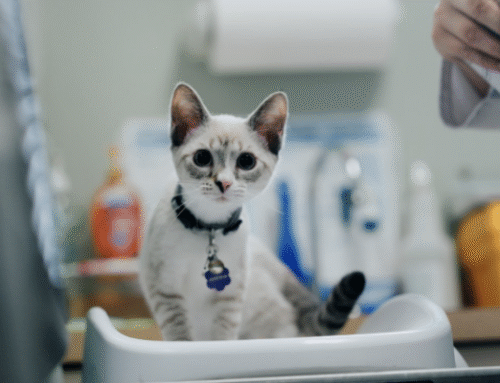Fleas and ticks are much more than a gross nuisance. These crawling, leaping pests can spread harmful diseases, trigger allergic reactions, and make your pet miserable. Fortunately, outsmarting these tiny interlopers is easy if you follow a consistent and multi-faceted year-round prevention plan.
Show parasites the door with these simple but powerful flea and tick prevention tips from the trusted Safe Harbor Animal Hospital veterinary care experts
Use a veterinarian-recommended flea and tick preventive
Veterinarian-recommended parasite preventives are most effective for eliminating and repelling fleas and ticks. Veterinary-endorsed brands and products have been extensively tested to ensure pet safety, including circumstances such as accidental overdose or inappropriate application. Prescription medications also have a faster speed-of-kill (i.e., the time a flea or tick takes to die after biting your pet), which reduces disease transmission.
Your Safe Harbor Animal Hospital veterinarian will make tailored preventive recommendations for your pet based on their health and exposure risks and your preferences (e.g., oral or topical administration). No matter which product you use, ensure you provide comprehensive parasite prevention and control by following the label directions and ensuring the preventive is given year-round.
Groom your pet regularly to check for parasite signs
Frequent grooming can reduce parasite risks because you can identify hidden pests or, more often, associated skin irritation or redness. Although administering flea and tick preventives consistently should minimize or eliminate parasite risks, regular brushing, combing, and bathing are a strong secondary defense against these inconspicuous insects.
Live fleas move quickly and are difficult to spot, but flea dirt (i.e., excrement from digested blood) is easy to identify. These droppings are granular and look like black pepper in your pet’s hair. This flea debris and corresponding skin irritation are commonly found around the tail base and along the pet’s spine, while attached ticks prefer to hide in well-concealed areas, such as the armpits (i.e., axilla), groin, ears, face, and under the tail.
Keep pet areas tidy to deter pests
Fleas and ticks rely on your pet as a food source, but they leave the pet to reproduce and lay eggs in the surrounding environment. Maintaining clean and clutter-free indoor and outdoor pet spaces can help to break the parasite life cycle and deter population growth. Maintenance includes:
- Trimming grass and weeds — Ticks like to hide in tall grasses while waiting for their next meal.
- Removing leafy debris and brush — Parasite-carrying mammals, such as rodents and rabbits, make their homes in leafy cover.
- Relocate wildlife feeding stations — Bird and squirrel feeders in your yard can attract deer, raccoons, and squirrels.
- Treat yards with a natural pet-safe pesticide — Natural repellents may reduce fleas, ticks, and mosquitoes in your yard, but first talk to your veterinarian to ensure the product is pet-safe.
- Vacuum carpets and floors — Frequent vacuuming removes flea debris and eggs that could lead to a home infestation.
- Launder pet beds weekly — Regular washing keeps your pet’s bedding parasite-free.
- Consult a professional pest service — Heavy or recurring flea infestations require professional intervention. Ensure the service you choose uses pet-safe chemicals. Remove your pets from the home during the treatment process.
Take precautions when exploring the great outdoors with your pet
Ticks prefer shady, moist, wooded areas, grassy fields, and thick vegetation where they can climb and wait for a passing meal (e.g., from birds or mammals, such as deer, rodents, and rabbits, humans, or pets). If you hike or spend time with your pet in common tick areas, take these precautions to ensure you both stay safe:
- Ensure your pet is up-to-date on flea and tick preventives.
- Outfit your dog with a bandana, vest, or collar treated with pet-safe repellent.
- Check your pet thoroughly for crawling or attached ticks before returning home.
- Take personal preventive measures (e.g., wearing long sleeves and pants, tall boots, bug spray) to avoid bringing ticks home to your pets.
- Remove attached ticks by grasping the head with tweezers or a tick-removal tool—never use your fingers or attempt to burn off the tick with fire or chemicals. Flush the tick down the toilet or submerge the pest in isopropyl alcohol. Wash your hands thoroughly after handling any parasite.
What you should do if you find parasites on your pet
Mild parasite problems can be easily treated by removing the offending pests, cleaning the pet’s environment, and keeping your pet current on veterinary-prescribed flea and tick preventives. However, serious infestations or allergic reactions (i.e., flea allergy dermatitis [FAD]) can have severe consequences and may require veterinary intervention and care.
If your pet indicates intense discomfort (e.g., frequent scratching, chewing), or has additional clinical signs (e.g., weakness or lethargy, especially in puppies or kittens), a visible rash, bites, or hair loss, contact Safe Harbor Animal Hospital to schedule an examination.
Parasites are a natural part of our world, but with diligent care and preventives, they will not pester your pet or compromise their health. For tailored flea and tick preventive recommendations for your dog or cat, contact Safe Harbor Animal Hospital, which is an Animal Hospitals of the Low Country practice.









Leave A Comment